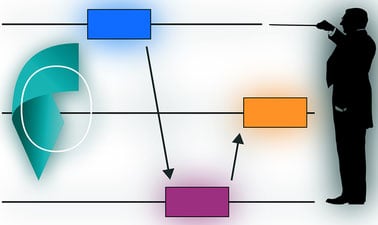- Level Expert
- المدة 21 hours
-
Offered by

عن
Imagine you want to design the following educational scenario. First, your students solve a problem individual. Next, you form pairs of students who obtained different solutions and ask them to choose the best of their two solutions. Finally, you display the produced solutions and compare them in your final lecture. This scenario needs to be managed dynamically: collecting individual solutions, forming pairs, collecting pair solutions and displaying them. It also requires opportunistic timing: you would like all individuals to complete their solution before moving to the team activity but you don't want to have many students waiting too long because one has not yet finished. These operations (timing transitions, collecting data, forming pairs) implement the orchestration of the designed scenario.
For designing this kind of lesson plan, this MOOC proposes a visual model, called orchestration graph. The vertices of the graph are the learning activities. Learners perform some of these activities individually; some activities are done in teams and some with the whole class. The edges of the graph connect consecutive activities. They are associated to operators that transform the data structures produced by learners during a learning activity into the data structures necessary to run the next activity. A graph of operators hence constitutes a workflow. The edges also describe why an activity is necessary for the next activity: is it a cognitive pre-requisite, a motivational trick, an advanced organizer, an organizational need, etc.
Instructional design is the process of building a sequence of learning activities though which learners will reach the learning objectives assigned to a session. Most instructional engineering methods are based on the decomposition of the target knowledge or skills into fragments and by sequencing them as chains or pre-requisites. The next step is to design learning activities for each unit of this sequence. Some activities are class-wide (e.g. a lecture), some in teams and some individual. The design skills addressed in this MOOC concern the construction of sequences that integrate these various activities, with a special focus on designing productive team activities.
The participants will first acquire the concepts by sketching graphs on paper and will next learn to use FROG, an online platform for Fabricating and Running Orchestrating Graphs.
Auto Summary
Unlock the potential of educational design with the "Instructional Design with Orchestration Graphs" course, a premier offering in the field of Personal Development. This expert-level course, presented by edX, introduces learners to a unique visual language for crafting intricate pedagogical scenarios. Emphasizing the seamless integration of individual, team, and class-wide activities, this course equips educators and instructional designers with advanced tools to enhance learning experiences. Over the span of 21 days, immerse yourself in comprehensive content that explores the nuances of orchestration graphs. Whether you are a seasoned professional or looking to elevate your expertise, this course offers flexible subscription options, including Professional and Starter plans, to suit your learning needs. Ideal for educators, curriculum developers, and instructional designers seeking cutting-edge strategies, this course promises to transform your approach to educational design. Join us and revolutionize your pedagogical toolkit today.

